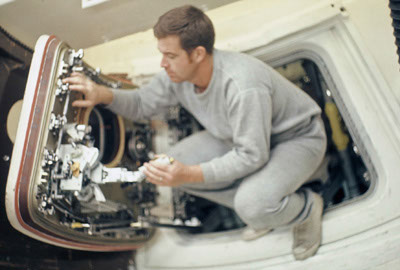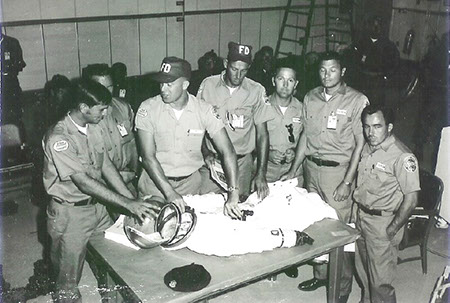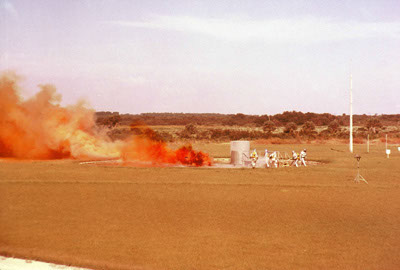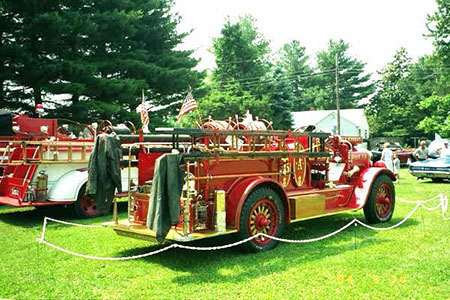 |
Welcome All !May 31, 2025 22:32
I am honored to continue to serve as President of the National Fire Heritage Center (Heritage Hall of America's Fire Services and Fire Protection Disciplines, Inc.).
My book, "Firefighting with Henry's Model T", a pictorial history of the role Henry Ford's Model T played in community fire protection sold out quickly and a few copies remain from the second printing. The second edition is nearly completed and should be available soon. A link is available to order a copy of the first edition or reserve a copy of the second edition. Please click here to email me if you have any information or pictures of Model T Ford fire apparatus you would like to see included in the Second Edition. In the past I had the distinct pleasure to photograph and drive one of the original "Crash Trucks" purchased by the US Army Signal Corps for airfield firefighting. Unfortunately I was unable to convince the owner that he should sell his 1918 Model T Ford American LaFrance Double Tank Chemical to me. The history and photographs of this unique vehicle is incorporated in the Second Edition and will be featured in a new book "Crash Trucks" to be published in 2013. 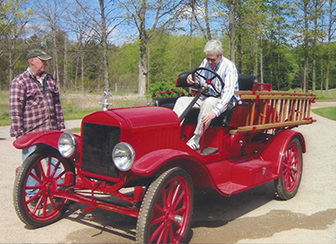
Chief Bill Killen and the 1918 Model T Ford American LaFrance Double Tank Chemical |
Apollo Astronaut Rescue Team (History in the making)
Following the tragic Apollo One fire that killed Astronauts Gus Grissom, Ed White and Roger Chaffee on January 27, 1967, NASA replaced the Crew Ingress – Egress Procedures published in 1966 with a revised Protocol for rescuing astronauts from the Apollo Command Module, The Astronaut Rescue Team was established October 7th, 1968 within the Kennedy Space Center Fire Department and began an intensive 12 week training program in preparation for the Apollo 8 launch to the moon..
Astronaut Rescueman Bill Killen examines the Apollo Command Module Door Locking System.
Kennedy Space Center Astronaut Rescue Team The original Apollo Astronaut Rescue Team was composed of volunteers selected from the ranks of the Kennedy Space Center Fire Department (KSCFD). Selected for Astronaut Rescueman on the original team were: L.S. "Clyde" Ball*, G. D. "Tadpole" Driskell, W.H. "Bill" Hogan, W. D. "Bill" Killen, J. O. "Joe" Morgan*, R.V. "Bob" Rinaldi, D. K. "Deke" Swift*, M. C. "Mel" Thorne, R. E. "Gene" Weldon. R. D. "Roy" Terry* was Team Commander and Arthur L. "Al" Wozniak was Team Leader and Aubrey R. Weldon was Fire Chief.
Astronaut Rescueman Bill Killen explaining the procedures for removal of helmet and oxygen lines from the Apollo Astronaut Space Suit.
Astronaut Rescueman Bill Killen demonstrating the emergency release mechanism on the Apollo Command Module.
Prior to each Apollo launch, members were selected from volunteers within the 120 member fire department to serve on the Astronaut Rescue Team. Following several months of study, Fire Chief Paul Pettelle incorporated rescue services within the KSC Fire Department combat structure on August 14, 1972. This team provided rescue services throughout the Kennedy Space Center, as well as Astronaut Rescue capability for the Apollo 17 and Skylab missions.
Astronaut Rescue Team performs rescue drill during hypergolic fire with nitrogen tetroxide and monomethyl hydrazine.
* indicates deceased members of this proud team. 
The Astronaut Rescue Team was disbanded February 11, 1974. 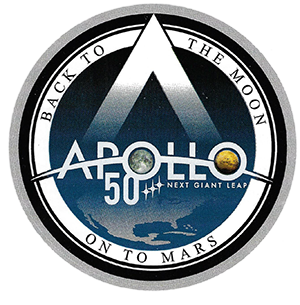 |
In Search of the StoughtonI purchased the 1923 Stoughton fire engine from the John Kress Estate Auction in July 1988. It was early summer in 1987 the first time I saw the Stoughton truck among at least forty antique cars, trucks and fire engines. At that time I was in my 32nd year in the fire service and I thought I knew every manufacturer of fire trucks in the United States, but to my amazement I had never heard of a Stoughton fire truck. Stoughton Wagon Works, Stoughton, Wisconsin was founded in the 1880's, manufactured trucks for the Army during World War I; and from 1920 until 1932 manufactured commercial trucks and fire trucks. In 1936 Stoughton Wagon Works went bankrupt and was sold to four employees who took over the assets and founded Stoughton Cab and Body. Stoughton Cab and Body produced cabs and bodies for several manufacturers, including Chevrolet and Ford. Today Stoughton trailers are manufactured in some of the same facilities used to build Stoughton Wagons, Stoughton trucks and Stoughton Cabs and Bodies. John Kress, a successful Wisconsin businessman had amassed a fantastic collection of Americana and housed his collection in a warehouse museum in Sparta, Wisconsin. I was seeking a small antique fire engine I could store in my garage. One of the nicest pieces in the collection was a 1920 Ford American LaFrance Ford Model TT which was a perfect fit for my garage. I made an offer on the truck, however Mr. Kress passed away and his collection was auctioned in July 1988. The auction took place while my family was in Europe and a friend represented me at the auction. The bidding for the 1920 Ford-American LaFrance quickly went beyond what I was willing to pay. My second choice was the Stoughton and my representative prevailed in the bidding against a bidder from Mundelein, Illinois who was representing a member of the Antioch Fire Department, Antioch, IL. The Stoughton was Antioch's first motorized fire truck and served Antioch until 1949.The Rockland Fire Protection District (Knollwood, Illinois) used the truck until the mid 1950's when it was sold to a private party. As the result of a fire that killed three children in Whitewater, Wisconsin in 1959 the Stoughton was recalled to service with the newly organized Lauderdale-LaGrange Volunteer Fire Department, where it served until 1961, when it was once again sold to a private party. 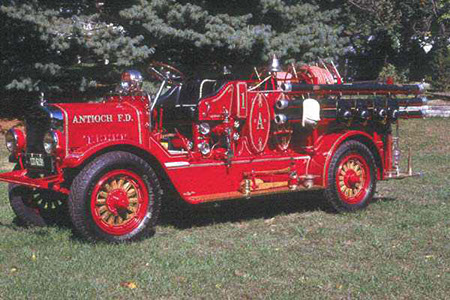 First photograph taken following completion of a frame-off restoration June, 1997. This 1923 Stoughton Community Fire Fighter was the first motorized fire apparatus of the Antioch Volunteer Fire Department, Antioch, Illinois. The rig is equipped with a Northern Fire Equipment package consisting of a Northern Rotary Gear 350 GPM pump, two sixty-two gallon water tanks, hose bed, two one-inch booster reels, wooden extension ladder, and three hard suction sleeves. The suction sleeves are the originals delivered with the truck in 1923. The truck arrived at its new home in Bowie, MD in August and with a new battery, gasoline in the tank, and the distributor cap removed, I bumped the starter to see if I had spark. To my amazement the engine turned over, fired once and ran like a top. MAGNETO WORKED! The truck was sound, nearly complete and needed a little cleanup. The paint was chipped and peeled in places, but for the most part the truck was in good shape. I spent the next six years chasing leads, rumors and stories about Stoughton trucks throughout Wisconsin, Illinois and Michigan. I must have visited every small town in Wisconsin looking for Stoughton trucks. I visited Stoughton Museum, where I copied files and records and eventually met the late Mr. Dewey Durnbaugh, who worked for Stoughton Wagon Works. Dewey was one of the four employees of Stoughton Wagon Works that bought the assets and founded Stoughton Cab and Body. What a delight to record Mr. Durnbaugh's experiences on a cassette recorder. As a result of my many trips "In Search of Stoughton," I found and purchased a 1923 Stoughton in rough shape, but for the most part complete and a 1925 Stoughton in pieces, and I mean pieces. After scavenging the parts from these trucks I sold the 1923 and the 1925 Stoughton trucks. September 1995, I started restoration with a chain saw removing the wooden tailboard. Each piece was photographed prior to and after removal. Small parts were labeled or tagged and placed in boxes, my garage looked like a parts store shelf with all of the parts boxes labeled and numbered. I sent the fenders, hose bed, water tanks and other sheet metal to be chemically stripped of paint and rust and stored the parts for the winter. By May 1996 I was down to the frame, engine, transmission and pump, when my brother-in-law, Marty Scott took the chassis to his shop. The first week of June was devoted to removal of dirt, grease, rust and paint. The only picture missing from my restoration book is of me completely rust colored from head to toe except for the portions of my face behind my eye glasses. Several days were spent trying to remove the right rear wheel from the axle. Over the next five months many hours were spent in preparing each part for painting. I don't think there is a piece of sheet metal on the truck that I didn't wet sand at least twice. Work pretty much stopped for the winter months and in May 1997 we went back to work. Assembly was completed except for lettering and trim in time to drive the truck in the July Baltimore Firehouse Exposition Parade. 
Best Appearing Antique Pumper Privately Owned 1900-1945 at the 50th Anniversary Firefighters Muster sponsored by the Westmoreland Volunteer Fire Department, May 30, 1998, Westmoreland, Virginia.
Rear view of 1923 Stoughton with period rubber firefighting bunker coats at the 50th Anniversary Firefighters Muster sponsored by the Westmoreland Volunteer Fire Department, May 30, 1998, Westmoreland, Virginia.
By September restoration was 98% complete and when the truck was returned to Antioch is was about 99% completed. I don't think it will ever be 100% restored. The first weekend in June 2007 the Stoughton was returned to the Village of Antioch, Illinois where it was delivered new in 1923. Thanks to the Antioch fire department, I had the pleasure of driving it one last time in the Antioch 4th of July Parade. The boxes of information, contacts, references and photographs of various Stoughton trucks along with Stoughton Wagon Works advertisements collected over thirty years has being compiled with interviews and letters from former Stoughton Wagon Works employees and Stoughton owners. This collection will soon be published in a book entitled "In Search of Stoughton".  |
Biography
Education and Professional Certifications
Leadership
|
Awards and Recognitions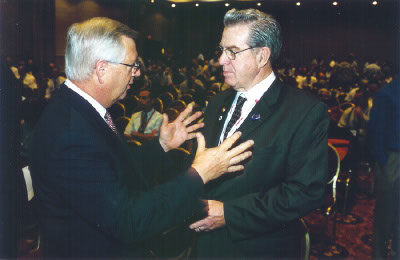
Chief Bill Killen and Congressman Curt Weldon (R) PA, Chairman of the Congressional Fire Caucus discuss continued renewal and support of the Fire Act (Assistance to Firefighters Grant Program)
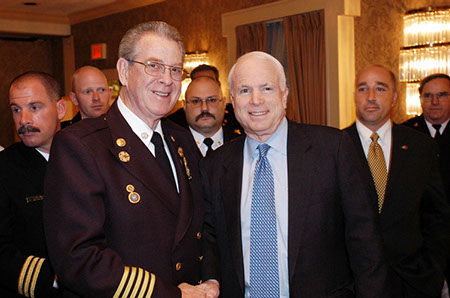
Chief Bill Killen with the late Senator John McCain(R). Rest in Peace. Go to Top |
History of ExperienceLeadership
Federal/Military
Municipal
Business
Professional Memberships
|
PublicationsBooks by Bill Killen
Books Co-Authored
Books Contributed
Articles Contributed to
|
|
Thank you for visiting my website and sharing my deep love and appreciation of the fire service. To email me click on this link: Bill Killen Email |
 Welcome to my website. I hope you enjoy the fire service history on this web page, which has been part of my fire service career for more than sixty-three years, as well as other fire service related information, photographs and links to other websites.
Welcome to my website. I hope you enjoy the fire service history on this web page, which has been part of my fire service career for more than sixty-three years, as well as other fire service related information, photographs and links to other websites.
